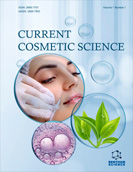Abstract
Background: Bio-based nanomaterials such as cellulose nanocrystals (CNCs) have been increasingly explored in nanotechnology owing to their chemophysical properties, self-assembly, and low toxicity.
Introduction: CNCs can be isolated from various cellulosic biomass sources. Textiles which are mostly made of cotton, are under-utilized biomass that after their lifetime is either burned or dumped into landfills.
Methods: In this study, cotton-based textiles are studied as a source of CNCs. CNCs were extracted from textiles with and without bleaching before the acid hydrolysis step, and further comparing them with the properties of industrial microcrystalline cellulose-derived CNCs. Nanocrystals were synthesized from the three different sources and their morphology, thermal properties, and colloidal stability were compared.
Results: The result show similar thermal properties and morphological characteristics for the three synthesized CNCs, and similar colloidal stability between the two textile-based CNC dispersions, suggesting that the dyes on CNCs do not impact the quality of the product. Removing the bleaching pre-treatment -a water-demanding and toxically harmful step- before CNC extraction provides cost and environmental benefits without compromising on the CNC quality.
Conclusion: This project seeks to streamline the CNC synthesis process with the long-term goal of eventually facilitating the textile recycling industry.
Keywords: textile, recycling, cellulose nanocrystals, acid hydrolysis
Graphical Abstract
[http://dx.doi.org/10.1016/j.jclepro.2018.02.266]
[http://dx.doi.org/10.1016/B978-0-08-100169-1.00009-5]
[http://dx.doi.org/10.3389/fchem.2020.00392] [PMID: 32435633]
[http://dx.doi.org/10.1016/j.carbpol.2012.05.026] [PMID: 22839998]
[http://dx.doi.org/10.1088/2043-6262/7/3/035004]
[http://dx.doi.org/10.1039/c0cs00108b] [PMID: 21566801]
[http://dx.doi.org/10.1016/j.ijbiomac.2019.03.027] [PMID: 30844460]
[http://dx.doi.org/10.1021/ja037055w] [PMID: 14624578]
[http://dx.doi.org/10.1016/j.carbpol.2016.10.044] [PMID: 27988013]
[http://dx.doi.org/10.1007/s10570-013-0158-2]
[http://dx.doi.org/10.1021/acssuschemeng.2c00797]
[http://dx.doi.org/10.1177/004051755902901003]
[http://dx.doi.org/10.1007/s10570-012-9714-4]
[http://dx.doi.org/10.1007/s10570-006-9061-4]
[http://dx.doi.org/10.3390/ma14185313] [PMID: 34576536]
[http://dx.doi.org/10.1016/B978-0-08-100557-6.00003-1]
[http://dx.doi.org/10.1039/C6CS00895J]
[http://dx.doi.org/10.1021/bm034519+] [PMID: 15360274]
[http://dx.doi.org/10.1007/s10570-018-2175-7]
[http://dx.doi.org/10.1021/bm400219u] [PMID: 23458473]
[http://dx.doi.org/10.1107/S0021889810043955]
[http://dx.doi.org/10.1007/s10570-018-2086-7]
[http://dx.doi.org/10.1016/j.carbpol.2013.06.004] [PMID: 23987369]
[http://dx.doi.org/10.1007/s10570-012-9730-4]
[http://dx.doi.org/10.1016/j.ijbiomac.2018.12.202] [PMID: 30593806]
[http://dx.doi.org/10.21748/am20.197]
[http://dx.doi.org/10.1016/j.carbpol.2020.116283] [PMID: 32475567]
[http://dx.doi.org/10.1016/j.carbpol.2017.07.087] [PMID: 28917896]
[http://dx.doi.org/10.1039/C9EN00472F]
[http://dx.doi.org/10.1016/j.scitotenv.2021.145871] [PMID: 33631573]













